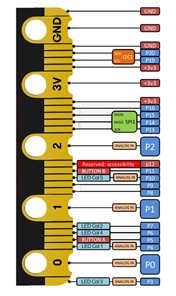3.6/3.7V Dual 18650 Rechargeable Lithium Battery Charger
sim7670c ic is good but it booting is very complication any other metod to connect 4G pius sms read and write
2A Dual L298N Motor Driver Module with PWM Control

BBC Micro:Bit V2.2
Let us know!
We'll try to match the price for you
We’ll notify you once the product is back in stock.
Couldn't load pickup availability


If you are looking to start programming or would like an exciting device to get young people interested in coding – then the BBC micro:bit V2.2 is perfect for you!
Created by the BBC working in partnership with other brands, the micro:bit is a small, programmable computer that has been designed to inspire children and young people to learn about programming and electronics in a practical and fun way.
This single board computer has an impressive ARM Cortex m4 processor and 512KB of flash, making it a capable little device. The micro:bit comes in 4 colours and has various individually programmable inputs and outputs including a 5×5 LED matrix display, buttons, speakers, and microphone. The micro:bit also features a temperature sensor, accelerometer, touch-sensitive logo, and a built-in sleep/off mode.
It is compatible with lots of free online code editors designed for different knowledge levels across a number of different programming languages so you can find something to suit how you want to learn or teach. There are endless amounts of free projects, lesson plans and activities to try, so there is every reason to start your micro:bit journey today.
read more : Microbit vs Microbit V2



|
Brand |
BBC Micro:Bit |
|
Model |
Micro:Bit V2.2 |
|
Processor |
Nordic Semiconductor nRF52833 processor |
|
Core Variant |
Arm Cortex-M4 32bit processor with FPU |
|
Flash Memory |
512KB Flash |
|
RAM |
128KB RAM |
|
Pins |
25 |
| Speed | 64MHz |
| Dimensions(LXB) | 40 x 50mm |
|
Weight |
120 grams |
Brand
BBC Micro:Bit
Model
Micro:Bit V2.2
Processor
Nordic Semiconductor nRF52833 processor
Core Variant
Arm Cortex-M4 32bit processor with FPU
Flash Memory
512KB Flash
RAM
128KB RAM
Pins
25
Weight
120 grams
This product comes with a 1-year manufacturer warranty from the date of purchase, covering manufacturing defects only.
The product shows signs of physical damage, mishandling, exposure to water/moisture, fire, natural calamities, unauthorized repairs, improper storage near heat or direct sunlight, or alteration in any way.